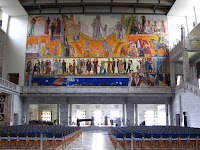An Oslo Card is well worth buying, to spend a day on the island of Bygdoy. With the card, the ferry ride is free, as are the five excellent museums there. We had decided we would like to visit them all.
First up was the Norwegian Folk Museum. About 170 old buildings have been relocated there, and the costumed custodians are very knowledgeable and helped us understand how they were built. Nothing changed for centuries, and in fact the women of isolated villages wore the same traditional style of dress from the 14th to the 20th centuries.
As well as rural farmhouses and food store buildings, the reconstructed village also had a magnificent wooden church. This was similar in style to several we had seen in rural Russia.
As well as the old rural style of architecture, they had also reconstructed a more modern town, complete with pharmacies from different eras, four storey apartment building (refurbished to show different eras and tenants), merchant's house and a fascinating look at the history of dental surgeries.
This took us several hours to view, so it was time to press on. Next up was the Viking Museum. The Viking ships on display were found in burial mounds, and also on show were artefacts needed in the next world. The building was once a church, and the high ceilings were perfect to display the boats.
We walked to the next bay, where the excellent Kon Tiki Museum was also well worth visiting. The original Kon Tiki balsa wood raft built by Thor Heyderdal was on display, as well as the papyrus Ra II. The Kon Tiki sailed from South America to Easter Island and Ra II completed the theory by sailing from Egypt to South America.
Thor's aim was to prove the links between Egyptians, Mayan and Polynesian depictions of boats and platform temples. So, theoretically the Egyptians were able to sail in papyrus boats to Polynesia via South America, and left evidence of their culture in building pyramid type buildings.
Next door is a Museum commemorating the life of Roald Amundsen and his ship 'Fran' which took him to the Antarctic, where he was the first to successfully reach the North and South Poles and lived to tell the tale. The Museum was purpose built around the ship.
Next to this Museum is the Maritime Museum, which we nearly skipped, but were pleased we didn't, as there is an excellent film shown on five screens, with fantastic scenery. We were inspired by this to decide that we would like to come back to Norway to tour the northern fishing villages.
Back in Oslo we had enough time to visit the Town Hall. This stunning Art Deco building is open for the public to wander around. Next time we hear that the Nobel Peace Prize has again been awarded, we'll be able to picture the ceremony in this magnificent building.
The Queen Mary II was in port, and we walked back through the Akershus Fortress at the top of the cliffs, to get a great view of the cruise liner. The Fortress is well worth a visit, its buildings date back to the Middle Ages, and occupy the commanding cliff-top position above the harbour.
Subscribe to:
Post Comments (Atom)














No comments:
Post a Comment